Beeton's Book of Needlework | Berlin Work Instructions
BERLIN WORK INSTRUCTIONS
Berlin Work includes every kind of stitch which is made upon canvas with wool, silk, or beads. The principal stitches used are common cross stitch, Gobelin stitch, leviathan stitch, raised or velvet stitch, tent stitch, and others. The materials and needle must always be carefully chosen of a corresponding size. For common cross stitch and raised stitch Penelope canvas must be used; for small articles, such as slippers, bags, or borders, single Berlin wool is preferable; for larger ones fleecy wool or double Berlin wool (the latter, however, is much more expensive). For Gobelin stitch and tent stitch undivided canvas (not Penelope) is required. Purse silk is often used for the latter; it is more brilliant than floss silk or filoselle. Floss silk is generally used for other stitches because it covers the thread of the canvas better than purse silk; it is, however, often replaced by filoselle, which is a much cheaper material. Moss wool is hardly ever used. Before beginning to work upon a piece of canvas the raw edges must be hemmed or sewn over with wool. Care must be taken not to crumple the canvas in the course of the work. It is best to roll one end of the canvas upon a round piece of deal while the other end is kept down upon the table with a lead cushion. Handsome artistic patterns should always be worked in a frame. When you undertake to work a large pattern begin in the centre, and complete one half before you commence the other. Always work the stitches in the same direction, from the top downwards--this is very essential to the beauty and regularity of the pattern.
Always begin with the colour which is used the oftenest; those colours that lose their dye in working must be put in last. When the pattern is finished begin the grounding. The wool must not be drawn too tightly, otherwise the threads of the canvas appear. If the wool is too coarse for the canvas, one long stitch is to be made from left to right as far as the particular colour is to be worked, and over this long stitch, cross back in the usual way.
The plainest stitch in Berlin wool work is the common cross stitch; illustrations 577 to 584 show varieties of the same.
We now proceed in the following pages to show, by description in writing and by most careful illustration, all the stitches which are used in Berlin Work. These are numerous, but neither too great in number nor too simple or too elaborate in execution for those who aspire to become Berlin workers.
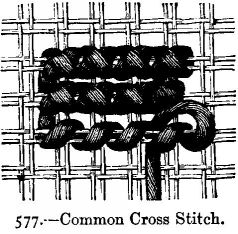
ILLUSTRATION 577.--The common cross stitch is worked in rows backwards and forwards over 2 threads in height and 2 in width (square of the canvas) in straight lines; the 1st row is worked from left to right; the 2nd row, which completes the stitches, from right to left. Illustration 577 shows 2 rows of completed stitches and 1 row in course of working.
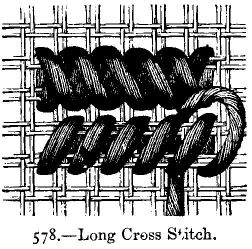
ILLUSTRATION 578 shows the long cross stitch. It is worked like the preceding one, only over 4 threads in height and 2 in width.
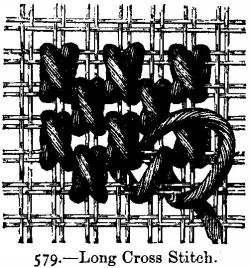
ILLUSTRATION 579 shows a long cross stitch, which is worked like the preceding one, except that 2 threads are missed between 2 stitches, and in the next row the stitches are worked between those in the preceding row. This stitch is not worked in rows backwards and forwards; each stitch is completed before beginning the next.
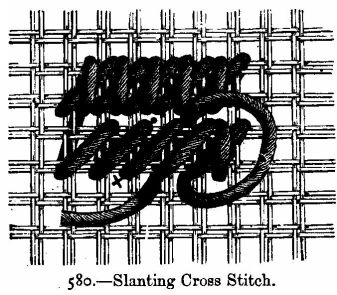
ILLUSTRATION 580.--The long slanting cross stitch is worked like No. 578, in rows backwards and forwards; the 1st row is slanting, the 2nd is straight. The places for inserting the needle and for drawing it out are marked on the illustration with a cross and dot.
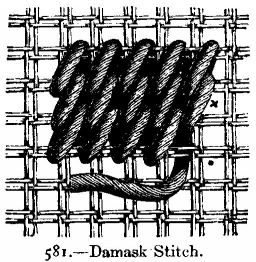
ILLUSTRATION 581.--The damask stitch is worked in single rows from left to right, over 4 threads in height and 2 in width. The stitches of one row come between those of the next. The cross and dot shown in illustration are where to insert and draw out the needle.
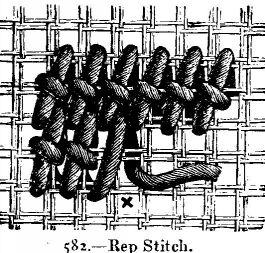
ILLUSTRATION 582 shows the rep stitch--a variety of the preceding. The first half of it is worked slantways over 6 threads in height and 2 in width, the second half, like the common cross stitch, from right to left over the 3rd and 4th of the 6 canvas threads; each stitch is completed at once. The illustration shows the last stitch being worked; the first half of the stitch is completed; the dot shows where the needle must be inserted for the second half; it is drawn out where the cross is placed on illustration.
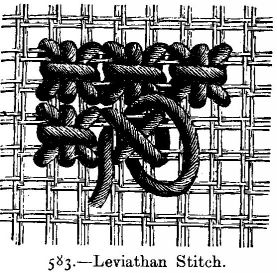
ILLUSTRATION 583.--The leviathan stitch consists of 1 slanting and 1 straight cross stitch over 4 threads in height and 4 in width. Each stitch is completed immediately. No. 583 shows one half of the stitch completed and the wool as it must be placed for working the first half of the straight cross stitch.
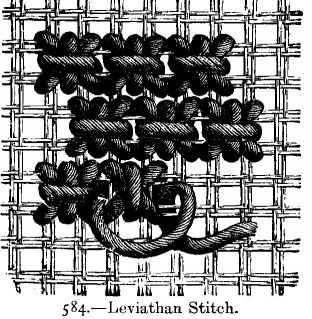
ILLUSTRATION 584.--The leviathan stitch is worked exactly like the preceding, only the stitches are not worked on the same threads in the different rows, as may be seen from illustration.

ILLUSTRATION 585.--The double leviathan stitch is a variety of the preceding; it is worked over 6 threads in height and as many in width. Make a common cross stitch over these 6 threads, then a long cross stitch in height and a long cross stitch in width. Illustration 585 shows 2 stitches completed and 1 being worked.

ILLUSTRATION 586.--Tent stitch. Each stitch is worked over 1 stitch in height and 1 in width, and is worked in rows from left to right.
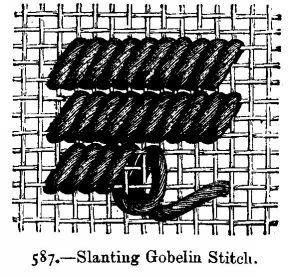
ILLUSTRATION 587.--The slanting Gobelin stitch is worked on undivided canvas; each stitch is worked over 3 threads in height and 2 in width, divided from the next stitch only by an interval of 1 thread.
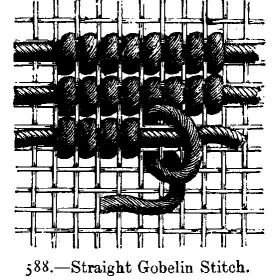
ILLUSTRATION 588.--The straight Gobelin stitch is worked over 2 threads in height with 1 thread between, so that the stitches appear more raised; they are worked over thin cord or a thick piece of wool.
ILLUSTRATION 589.--The raised or velvet stitch is worked over small round wooden meshes, and forms small raised loops. Take 2 similar meshes and as many threaded needles as there are colours in the work; make first a slanting stitch, as for the beginning of the common cross stitch, but instead of drawing out the needle straight under the place where it was inserted, draw it out exactly at the same place, so as to form a slanting stitch on the right and on the wrong side; then begin to work over 1 mesh; insert the needle above it and draw it out in a slanting direction underneath. On the wrong side of the work a regular cross stitch is formed. Illustration 589 shows 2 rows of velvet stitch completed and 2 rows being worked; the first of the latter is yet on the mesh, the second being worked so as to show the position of the wool upon the mesh. Observe that the rows of the velvet stitch are worked upwards, and that 2 meshes are necessary, because the lower one must not be drawn out before the next row is completed. The loops may be cut open if preferred.
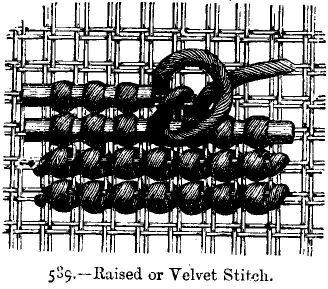
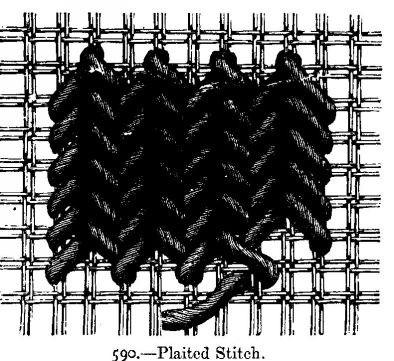
ILLUSTRATION 590.--The plaited stitch is worked like the herring-bone stitch. Each stitch is worked over 4 threads in height and 4 in width. Illustration 590 shows one part of the plaited stitch completed, and the place where the needle is to be inserted for the next stitch is marked by a dot. For the next stitch the needle is carried under the 2 threads below the stitches of the preceding row.
ILLUSTRATION 591.--The plush stitch is also worked upwards. Begin to work a common cross stitch, then insert the needle through the canvas over 2 threads in height and 2 in width, downwards in a slanting direction. Do not draw the wool close up, but leave a loop hanging down about four-fifths of an inch long, and make 1 more common cross stitch to fasten the loop. This stitch can also be worked over flat meshes. Work a common cross stitch at the end of every row. When the work is completed the loops are cut open and clipped, as may be seen from illustration.
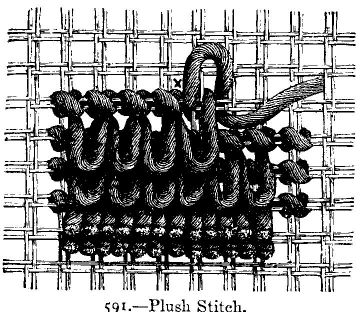
ILLUSTRATIONS 592 to 594.--Three Berlin wool work borders for trimming baskets, &c. No. 592.--The 2 outer rows which edge the border are worked in long straight cross stitch; each stitch is crossed in the centre with a back stitch.
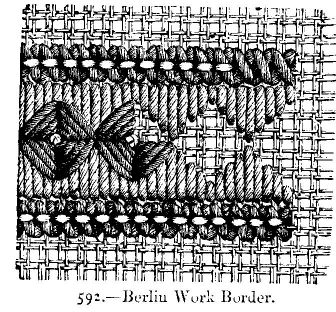
The grounding consists of 2 rows of vandykes placed opposite each other, which are formed of long straight stitches of different lengths. The squares in the centre are formed in the same way, and are completed in the middle with a knot.
No. 593.--The ground is worked in cross stitch, the raised patterns in satin stitch; in the middle of each pattern there is a cross stitch. The outer rows are worked in half cross stitch over 2 threads in height and 4 in width in 2 different shades. No. 594.--The petals of the flowers are worked over 4 threads in height and in width, and consisting of 4 slanting stitches.

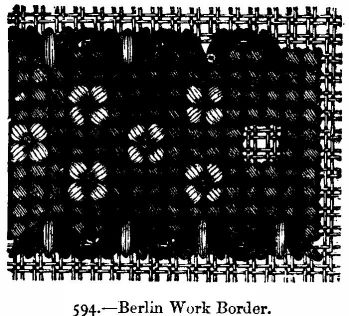
In the centre the flower is completed by a knot; the ground in cross stitch is completed on either side by a narrow border of scallops, formed of slanting stitches divided in the centre by 1 slanting stitch. It is easy to work these stitches from illustration. The choice of colours depends upon what use the border is intended for and upon personal taste.
| Pattern Categories Browse the categories to help you find the patterns you're looking for. |
||







